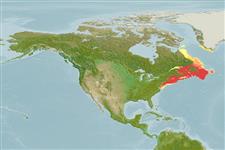Environment: milieu / climate zone / depth range / distribution range
Ecology
Marine; brackish; demersal; oceanodromous (Ref. 51243); depth range 0 - 388 m (Ref. 58426). Temperate; ? - 10°C (Ref. 35432); 63°N - 37°N, 80°W - 43°W
Northwest Atlantic: Labrador, Canada to Delaware, USA.
Length at first maturity / Size / Weight / Age
Maturity: Lm 28.8 range ? - ? cm
Max length : 110 cm TL male/unsexed; (Ref. 7251); max. published weight: 5.4 kg (Ref. 4926); max. reported age: 18 years (Ref. 796)
Benthic; feeds on worms, crustaceans, molluscs, sea squirts, sea urchins and fishes (Ref. 58426).
Life cycle and mating behavior
Maturity | Reproduction | Spawning | Eggs | Fecundity | Larvae
Eggs are laid in gelatinous masses guarded by one or both parents until hatching (Ref. 35432). However, more recent evidence suggests that care is provided by the female alone (Ref. 104883).
Anderson, M.E., 1994. Systematics and osteology of the Zoarcidae (Teleostei: Perciformes). Ichthyol. Bull. J.L.B. Smith Inst. Ichthyol. 60:120 p. (Ref. 11954)
IUCN Red List Status (Ref. 130435: Version 2024-1)
Threat to humans
Harmless
Human uses
Fisheries: commercial; aquarium: commercial
Tools
Special reports
Download XML
Internet sources
Estimates based on models
Preferred temperature (Ref.
123201): 0.4 - 9.5, mean 3 °C (based on 227 cells).
Phylogenetic diversity index (Ref.
82804): PD
50 = 0.5156 [Uniqueness, from 0.5 = low to 2.0 = high].
Bayesian length-weight: a=0.00186 (0.00121 - 0.00287), b=3.20 (3.07 - 3.33), in cm total length, based on LWR estimates for this species & (Sub)family-body (Ref.
93245).
Trophic level (Ref.
69278): 4.2 ±0.1 se; based on diet studies.
Generation time: 14.5 ( na - na) years. Estimated as median ln(3)/K based on 2
growth studies.
Resilience (Ref.
120179): Low, minimum population doubling time 4.5 - 14 years (K=0.08-0.11; tmax=18).
Prior r = 0.09, 95% CL = 0.06 - 0.14, Based on 2 full stock assessments.
Fishing Vulnerability (Ref.
59153): High to very high vulnerability (67 of 100).
Climate Vulnerability (Ref.
125649): High to very high vulnerability (74 of 100).
Nutrients (Ref.
124155): Calcium = 21 [13, 34] mg/100g; Iron = 0.251 [0.157, 0.407] mg/100g; Protein = 18 [15, 20] %; Omega3 = 0.436 [0.268, 0.701] g/100g; Selenium = 21.5 [11.0, 41.1] μg/100g; VitaminA = 9.16 [3.35, 25.13] μg/100g; Zinc = 0.458 [0.342, 0.634] mg/100g (wet weight);
